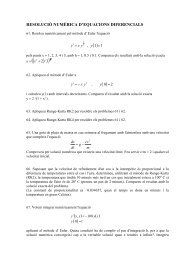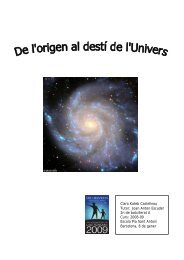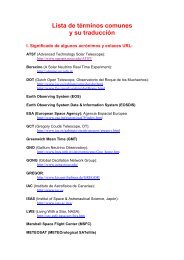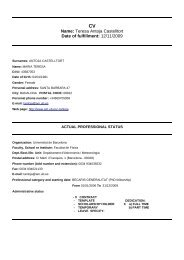Universitat de - Departament d'Astronomia i Meteorologia ...
Universitat de - Departament d'Astronomia i Meteorologia ...
Universitat de - Departament d'Astronomia i Meteorologia ...
Create successful ePaper yourself
Turn your PDF publications into a flip-book with our unique Google optimized e-Paper software.
2.4. The radio counterpart: NVSS J182614−145054 51<br />
Table 2.2: EVN array used in the LS 5039 observations.<br />
Antenna Co<strong>de</strong> Location Diameter DPFU (a) Tsys (b)<br />
[m] [K Jy −1 ] [K]<br />
Effelsberg EB Germany 100 1.47 27<br />
Jodrell Bank JB U.K. 25 0.11 40<br />
Cambridge CM U.K. 32 0.21 38<br />
Westerbork WB Netherlands 14×25 1.0 67<br />
Medicina MC Italy 32 0.15 53<br />
Noto NT Italy 32 0.16 47<br />
Toruń TR Poland 32 0.15 31<br />
(a) Degrees per flux unit. (b) Best value during the experiment.<br />
32 MHz bandwidth. We analyzed the left hand circular polarization data excluding<br />
1 MHz channel at both edges of the band, yielding a final bandwidth of 14 MHz.<br />
The correlator integration time was of 4 s. Standard reduction and imaging analysis<br />
were carried out using aips and difmap.<br />
To complement the amplitu<strong>de</strong> calibration, we interleaved cross-scans (in azimuth<br />
and elevation) with the 100 m Effelsberg antenna to measure the radio source flux<br />
<strong>de</strong>nsities (A. Kraus, private communication). We fitted a Gaussian function to the<br />
flux-<strong>de</strong>nsity response for every cross-scan, and we averaged the different Gaussians.<br />
We linked the flux <strong>de</strong>nsity scale by observing primary calibrators such as 3C 286,<br />
3C 48, or NGC 7027 (see e.g. Kraus 1997 or Peng et al. 2000).<br />
Unfortunately, the flux <strong>de</strong>nsity monitoring with the Effelsberg antenna was not<br />
reliable due to contamination effects by the galactic plane diffuse emission and/or by<br />
the close SNR G016.8−01.1. However, inspection of the shortest MERLIN baselines<br />
reveals a constant flux <strong>de</strong>nsity during the full run. That allowed us to image the<br />
source directly without splitting the data in time blocks. We present the obtained<br />
EVN and MERLIN images in Figs. 2.8 and 2.9, respectively. The MERLIN image is<br />
presented convolved with a circular beam, equivalent in solid angle to the interfero-<br />
metric synthesized beam of 142×46 mas at position angle (P.A.) 1.15 ◦ . Our images<br />
clearly show that LS 5039 has a two-si<strong>de</strong>d jet emanating from a central core. In<br />
both images the southeast (SE) jet is brighter and larger than the northwest (NW)<br />
one, as can be seen in Table 2.3, where we have quoted the flux <strong>de</strong>nsities of the core<br />
and the jets and the lengths and P.A. of the jets. Their total lengths are ∼ 60 mas<br />
in the EVN image and ∼ 300 mas in the MERLIN one.






